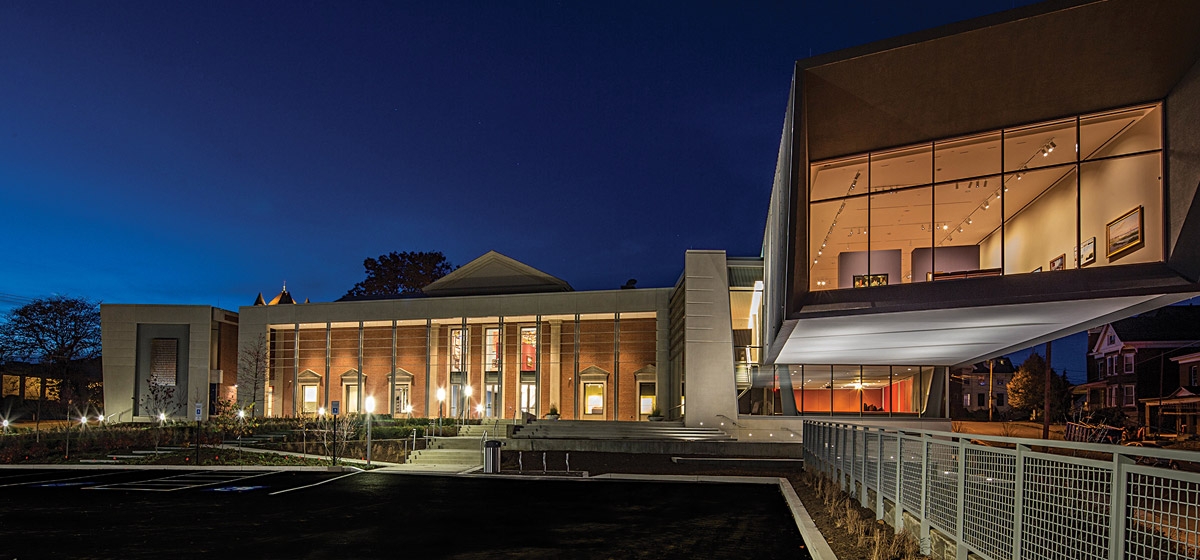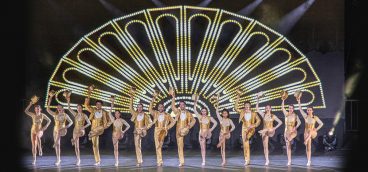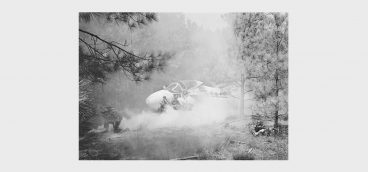
Early in October, looking out over the view of Greensburg from the newly reconfigured Westmoreland Museum of American Art, someone remarked that a building’s foundations had been discovered recently in the old parking garage, which is being turned into a garden. In England, such work recently turned up the body of King Richard III, slain in 1485 and mislaid in the 17th century. Alas, no such event in Greensburg, but the brickwork is likely to be the foundation of Mary Marchant Woods’s house.
She lived and died there in 1950, leaving her property and capital to found what was then to be known as the Westmoreland County Museum of Art. In 1958, the museum was completed, a neo-Georgian pile (pediment, columns, stone windows, brick walls) that housed a secret: its footprint and floor plans were the work of one of America’s greatest modernist architects, Philip Johnson, whose original “modern” design for the building was reworked by local architects into something “safer” for conservative western Pennsylvania. Those original plans still survive in the WMAA’s archives. On its 50th anniversary and after a few “re-fits,” a strategic plan indicated a need for something more radical. Now you would scarcely recognize this museum.
Yet, for all this work, we have something familiar, as I discovered while the finishing touches were being applied in early October. There is a phenomenon known as site memory, where the past is uncannily present in a particular location, and to walk though The Westmoreland’s reconfigured spaces is to sense both the new and the old.
Ennead Architects of New York City have effected this transition. To be sure, there is a brand new cantilevered wing jutting out towards the city, which brings the outdoor and urban experience into the physical confines of the building. Through a screened terrace, a grand new staircase overlooks a garden that hugs the structure (and, in season, opens it out further). The staircase serves to prepare the visitor for the gallery level. To the right, the new, 16-foot-high cantilevered gallery offers a prospect of large contemporary art exhibitions that previously were not available. And slightly to the left are large galleries devoted to modern art of the 20th and 21st centuries.
“…to walk through The Westmoreland’s reconfigured spaces is to sense both the new and the old.”
“21st” is a novelty here, and a dedicated space for it is incorporated into the newest part of the building. A loose rule dictated that WMAA’s collecting policy should be confined to the years before the original building was erected. Post-1960 art, however, was collected and uncomfortably slipped in—a slight to those contemporary artists, both regional and national, who continue and question the traditions of American art. This has now been changed and has made possible new donations and acquisitions.
The visitor is now standing in the old part of the building. Here the changes have been radical, largely because of the space’s proximity to the new structure. Once, this was the main exhibition gallery used for a whole series of temporary exhibitions. Before that, for those who can remember it, a series of small booths displayed the substantial collections that the museum’s first director, Dr. Paul Chew, had amassed. My first impression of The Westmoreland in the early 1980s was of a museum that told the story of art and a region through its many collections, and mediated by the director’s taste. (This is usually the first phase of most museums’ existence.) And it is in these modern spaces that the taste of the second and current director, Judith Hansen O’Toole, aided by her long-time chief curator, Barbara Jones, can be seen at its most expansive. Neither of these two women are academic specialists in this period; rather they are acknowledged experts in particular areas of 19th century American painting.
Here, modernism is teased out from many strands—primitive, abstract, social realist, even political—to make a coherent statement about the American-ness of American Art. This is economically done, without calling in Andy Warhol, Jasper Johns and many of the stellar artists of the recent and immediate past. By and large, these artists are not here (maybe some day they will), but already an immeasurably important step has been made with the large gift of contemporary art by Dr. Peter and Diana Janetta, part of which is being shown in the rear of the cantilevered gallery.
The jewel in The Westmoreland’s crown is its collection of western Pennsylvanian art, which begins with what is effectively documentary material, straightforwardly painted. One thinks of William Coventry Wall, whose skills were only marginally above the primitive, but who fully conveys the magic of a pristine landscape coming to terms with the march of progress. Later artists, with some German training (one thinks particularly of George Hetzel) and a sense of what was also an emerging American aesthetic, are manifest in what has come to be known as the Scalp Level school. This work is currently hung, academy-style, in the old central gallery, which, despite many alterations, retains the feel of the old neo-Georgian cube room, looking out from behind the now columnless portico.
This is the moment to reflect on what a new museum The Westmoreland has become. The cube room was the locus of old-style museum society. An open well set in the middle of this room looked down from above into the entrance hall of the building, where a terrazzo map of Westmoreland Country could be read on the floor. The director could look down from his office on high above the cube room through a series of windows (now blocked up). A grand piano was set up for social occasions, and strong cocktails often were consumed at openings and receptions. In retrospect, it was a little divisive. Now, instead of being an antechamber to the galleries, it has been pared down to a gallery itself, and the social encounters (which are still important, if more varied) have been moved by the architects to other, more functional spaces.
The point is further driven home by the fact that this space is now also hung with other witnesses to the history of western Pennsylvania, documenting the industrial and social dimensions of the story, of factories and of labor, with tougher and more politicized content. They are hung, at least for the time being, almost confrontationally on an opposing wall to that of the Walls and the Hetzels.
The remaining gallery space at The Westmoreland still conveys a sense of the old historical survey of American art that has always existed in the museum, from the days when the visitor to this section encountered the “porthole” portrait of George Washington followed by local and national paintings, with furniture and objects of art being further enlisted to advance the narrative. This is still the case today as in almost all other museums. The difference is that over the past 50 years, the collections have been greatly winnowed and at the same time greatly enlarged. It was perhaps one of O’Toole’s first ambitions to get The Westmoreland “accredited,” through which it could share in the prestige of the country’s best museums by submitting its collection to stringent study by museum experts and agreeing to abide by equally stringent standards of conduct. The good sense of accreditation is apparent. Donors and lenders are reassured.
The remodeling of the museum takes the opportunity to draw attention to three important recent gifts. The largest is 200 or so paintings from the Richard Mellon Scaife estate. A fraction fills the new, cantilevered gallery (there are too many to show all at once) as well as appearing elsewhere in the building. Note in particular a small group of paintings by the Pittsburgh primitive (and proto-modernist?) John Kane that used to hang in one of Scaife’s many drawing rooms. The museum needed them, and they were specifically given. (Two more exhibitions of the Scaife bequest are planned in the near future.) Fittingly, Scaife’s name has been added to the director’s full title, in honor of his generosity.
Another collection also makes its first appearance at The Westmoreland’s reopening. Dr. Michael Nieland is giving his entire collection of American sculpture, mainly bronzes, which will be the subject of a major exhibition opening in 2017. Nine of nearly 60 of these already are in the museum’s care and have been installed in the main galleries, complementing the museum’s small sculpture collection. Philip Johnson’s original plans had proposed a sculpture garden, which had been only slightly realized. Dr. Nieland’s collection is exclusively figural and includes some major examples of the genre.
Both of these donated collections build on the museum’s existing holdings. The third, however, is entirely transformative. Dr. Peter and Diana Janetta have built a collection of contemporary art (with a few less- contemporary pieces) that effectively point the museum in an entirely new direction. As noted earlier, the museum’s collection was limited by its terms to exclude “contemporary” art. Mid-20th century Greensburg was a conservative town, and like most western Pennsylvanian communities, it experienced economic decline. Since then, the situation has slowly changed. Two universities have developing campuses in the neighborhood, with Seton Hill building a brand-new arts center, and both have increasing relations with the museum. The time is right for the contemporary.
When the museum was first built, there was fashion for “period rooms.” Two such were installed at that time, one more successfully than the other. They were anonymous gifts, but it was an open secret that they came from Penguin Court, the Scaife residence near Ligonier. At Penguin Court they were installed as stripped pine, which was fashionable in the early 20th century. But in their original setting somewhere in England in the 18th century, they were painted. One has now been painted white, considerably enhancing the architectural quality of the room; the other remains stripped. These interiors were never successful as “period rooms” or as galleries, and their future has been designated as a “center for creative connections” and as a reading room, setting the modern in the old spaces.
Upstairs is the essence of the museum, which is the collection, without which almost no museum could sustain an existence. It has been reconfigured to support what is downstairs, which is the springboard for achieving the full ambitions of a contemporary museum. On the ground floor on one side of the building’s main entrance are the staff offices. If there is an upstairs/ downstairs side to life, this is emphatically the downstairs side… more democratic but surely downstairs.
The other side of this entrance is for the visitors, who need to eat and drink, shop, learn about the place, go to lectures, art classes, and even party. Historically, these things were put together piecemeal. At the old Westmoreland, a gallery might become a gift shop, then partly a coffee bar or a book store. The new configurations have now been carefully strategized.
Finally, there is another lower floor where the collection is stored under optimized conditions and which houses necessary workshops and ordinary storage.
Today as the visitor approaches this museum, the old pediment peeks over the contemporary screen. It is a modest, symbolic and slightly surreal touch the architects have allowed.
And you greet this new museum in a new way. The architects have moved the garage, and you walk through what is in effect a garden; the first element of what will be a sculpture garden is in place. It’s the gift of that historic stalwart, the museum’s Westmoreland Society, whose gifts have sustained the museum from its inception.
You then enter the building, through the screen that filters light into what is still the point of entry, the old reception hall, now light and transformed. There is sophisticated technology at work here with many eco-sensitive solutions for the 21st century, but they in no way distract. The Westmoreland is set for another century and for a new Greensburg.





